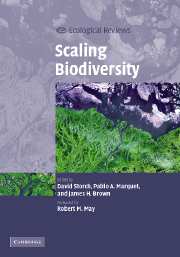Book contents
- Frontmatter
- Contents
- List of contributors
- Foreword by Robert M. May (Lord May of Oxford)
- Preface
- 1 Introduction: scaling biodiversity – what is the problem?
- PART I Spatial scaling of species richness and distribution
- 2 Species–area curves and the geometry of nature
- 3 The distribution of species: occupancy, scale, and rarity
- 4 Species distribution patterns, diversity scaling and testing for fractals in southern African birds
- 5 Geometry of species distributions: random clustering and scale invariance
- 6 Toward a mechanistic basis for a unified theory of spatial structure in ecological communities at multiple spatial scales
- PART II Alternative measures of biodiversity: taxonomy, phylogeny, and turnover
- PART III Scaling of biological diversity with energy and the latitudinal biodiversity gradient
- PART IV Processes, perspectives, and syntheses
- Index
- Plate section
- References
6 - Toward a mechanistic basis for a unified theory of spatial structure in ecological communities at multiple spatial scales
Published online by Cambridge University Press: 05 August 2012
- Frontmatter
- Contents
- List of contributors
- Foreword by Robert M. May (Lord May of Oxford)
- Preface
- 1 Introduction: scaling biodiversity – what is the problem?
- PART I Spatial scaling of species richness and distribution
- 2 Species–area curves and the geometry of nature
- 3 The distribution of species: occupancy, scale, and rarity
- 4 Species distribution patterns, diversity scaling and testing for fractals in southern African birds
- 5 Geometry of species distributions: random clustering and scale invariance
- 6 Toward a mechanistic basis for a unified theory of spatial structure in ecological communities at multiple spatial scales
- PART II Alternative measures of biodiversity: taxonomy, phylogeny, and turnover
- PART III Scaling of biological diversity with energy and the latitudinal biodiversity gradient
- PART IV Processes, perspectives, and syntheses
- Index
- Plate section
- References
Summary
Introduction
Macroecology, the search to identify and understand the origin of patterns in the distribution and abundance of species is a major focus of ecology (Gaston & Blackburn, 2000). Knowledge of such patterns is central to formulating local, national and global conservation and land use policies, as well as to the effort to understand the principles governing ecosystem function and temporal dynamics. Many mathematical models have been proposed and tested against specific macroecological patterns (e.g. He & Legendre, 2002) but few have been tested against the wide array of spatial metrics that can be derived from spatially explicit census data. Moreover, many of these models contain adjustable parameters whose values are difficult to determine a priori, and it is often unclear whether fitting parameterized models to data yields predictive insight into ecosystems. By testing highly constrained theory against a variety of metrics, as opposed to testing parameter-laden theory against a small number of metrics, the search for plausible underlying pattern-generating mechanisms may be expedited.
Two types of spatial metric are of interest here – those that characterize the distributions of individual species and those that characterize spatial structure in a community of species. Table 6.1 lists and defines a diverse set of spatial metrics of both types. The metrics are defined in terms of a scale label, i, which is explained in Box 6.1. That box also illustrates the definitions of the spatial metrics using a simple example.
- Type
- Chapter
- Information
- Scaling Biodiversity , pp. 101 - 126Publisher: Cambridge University PressPrint publication year: 2007
References
- 5
- Cited by



